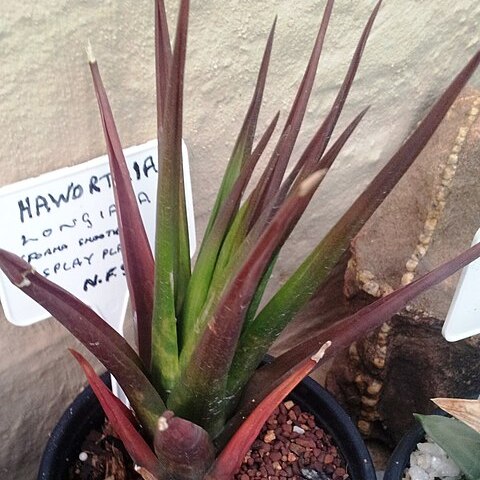Plant acaulescent, up to 32 cm tall, the leaves at the apex spreading to about 18 cm diam., proliferous from the base and forming clumps of about 2-6 plants. Leaves about 24, ascending (in the clumps the leaves on each plant are bent away from one another), firm, up to 30 cm long, up to 28 mm broad at the base, 4 mm thick at middle of leaf, lanceolate, acuminate-subulate; face concave, smooth, with a raised concolorous line in the lower 3/4, and beset with few to many inconspicuous, small, whitish round tubercles, the old leaves bright light green towards the apex, darker dull green below, the young light green towards the apex, light bluish green below; back convex, pale green towards the apex, darker green below, beset with many round and oblong bluish-white, up to 1.75 mm diam. tubercles on some plants, to about 0.5 mm diam. on others, many of the tubercles confluent, in some cases in all directions, in others forming irregular transverse bands, the tubercles very conspicuous in the lower 2/3 of leaf, less conspicuous above due to the lighter green colour of this part of the leaf, obliquely keeled from near the base to the tip, margins acute. Peduncle simple, +/-terete, 2.5 mm diam., including the raceme up to 60 cm long, very pale green below, becoming light glaucous green above; raceme up to 12 cm long, about 40 spirally arranged flowers and buds, 2-4 open simultaneously; pedicels 3.5 mm long, 1 mm diam., erect, light glaucous green; sterile bracts 4-6, the lowest about 26 cm from base of peduncle, 8.5 mm long including the awn; fertile bracts 5.5 mm long, deltoid-lanceolate, subulate, white with a nerve which is bright green and broad below, becoming greenish-brown and fine above; perianth white, greenish nerved, 17.5 mm long, the cylindrical-hexagonal sub-globose base 4 mm diam., and tapering to the pedicel, constricted to 3.5 mm above, oblong, ascending, curved; upper segments channelled, the 2 outer obtuse, very recurved, face colour white with a broad green nerve, the inner segment narrow obtuse, less recurved, face colour white at tip, light green below, with a broad very green nerve; lower segments obtuse, channelled, the 2 outer very recurved, replicate, face colour white at tip, light green below, with a medium broad very green nerve, the inner segment revolute, face colour white with a medium broad green nerve; stamens 7 and 5.5 mm long; ovary 3.5 mm long, 1.5 mm diam., ovate, bright green; style 1.25 mm long, green, with whitish tip, straight, not capitate.
More
Plants acaulescent, with leaves in a basal rosette about 180 mm diam., proliferous from the base, and forming clusters. Leaves about 24, up to 300 mm long, curved, up to 28 mm broad at the base, 4 mm thick at the middle of the leaf, lanceolate-acuminate to subulate; upper surface concave or flat, tubercled or smooth, with a raised concolorous line, green to light green; lower surface convex, green, with large or small tubercles, confluent or in irregular transverse bands, or glabrous; margins acute, keel 1, obliquely positioned along the entire leaf length. Inflorescence up to 480 mm long, bracteate; sterile bracts membranous, long acuminate, about 8.5 mm long, erect, keeled; raceme from about 120 mm long, lax, with about 40 spirally arranged flowers and buds, 2 to 4 open simultaneously; floral bracts membranous, up to 5.5 mm long; deltoid to lanceolate, keeled with brown or greenish-brown veins, clasping the pedicels, (longer than the pedicels); pedicels 3.5 mm long, 1 mm diam., erect, light glaucous green; perianth white with green or brown keels to the segments, up to 17 mm long, compressed at base, funnel-shaped, tube more or less 4.5 mm across, constricted to 3.5 mm above, straight; segments free to the base, 2 lipped, posterior segments erect or very slightly recurved, white, spreading, with green veins; exterior part very recurved, replicate, white with green veins; stamens 9 and 10 mm long, inserted within the perianth tube; ovary 6 mm long, 2 mm diam., light green; style 2 mm long, straight, capitate.
Proliferous, acaulescent. Leaves very elongate, > 300 mm long, 15-20 mm wide, rigid, erect-subulate, subscabrid, occasionally with conspicuous raised tubercles. Flowering time Oct.-Dec.
Acaulescent succulent, forming robust rosettes. Leaves often curving sideways from base, slender, rigid, light green, nearly smooth. Flowers white.

